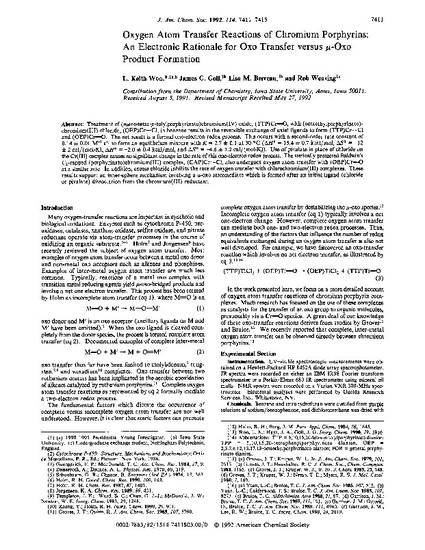
Treatment of (meso-tetra-p-tolylporphyrinato)chromium(IV) oxide, {TTP)Cr=O, with (octaethylporphyrinato)chromium( III) chloride, (OEP)Cr-Cl, in benzene results in the reversible exchange of axial ligands to form (TTP)Cr-Cl and (OEP)Cr=O. The net result is a formal one-electron redox process. This occurs with a second-order rate constant of 0.14 :1:: 0.01 M-1 s-1 to form an equilibrium mixture with K = 2.7 :1:: 0.1 at 30 °C (ill/* = 15.4 :1:: 0.7 kcaljmol, M* = -12 :1:: 2 cal/ (mol·K), ill/0 = -2.0 :1:: 0.4 kcaljmol, and M 0 = -4.6 :1:: 1.2 cal/ (mol·K)). Use of pivalate in place of chloride on the Cr(III) complex causes no significant change in the rate of this one-electron redox process. The sterically protected Baldwin's C2-capped {porphyrinato)chromium(III) complex, (CAP)Cr-Cl, also undergoes oxygen atom transfer with (OEP)Cr=O at a similar rate. In addition, excess chloride inhibits the rate of oxygen transfer with chlorochromium(III) complexes. These results support an inner-sphere mechanism involving a ~-oxo intermediate which is formed after an initial ligand (chloride or pivalate) dissociation from the chromium(III) reductant.
Available at: http://works.bepress.com/l-woo/93/

Reprinted (adapted) with permission from Journal of the American Chemical Society 114 (1992): 7411, doi:10.1021/ja00045a012. Copyright 1992 American Chemical Society.